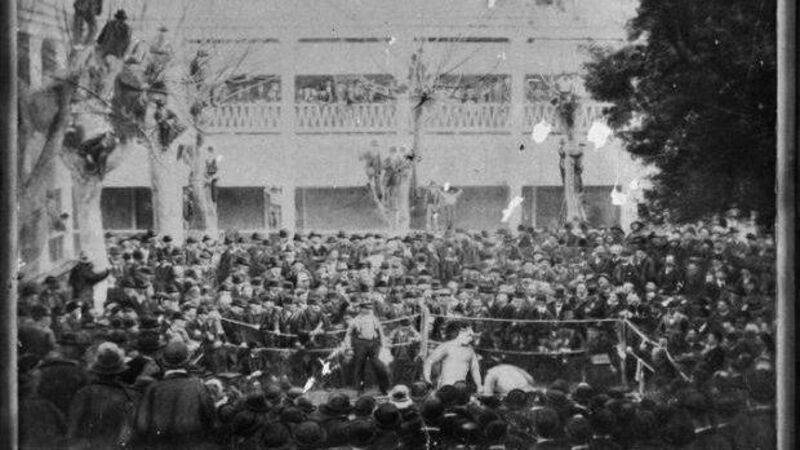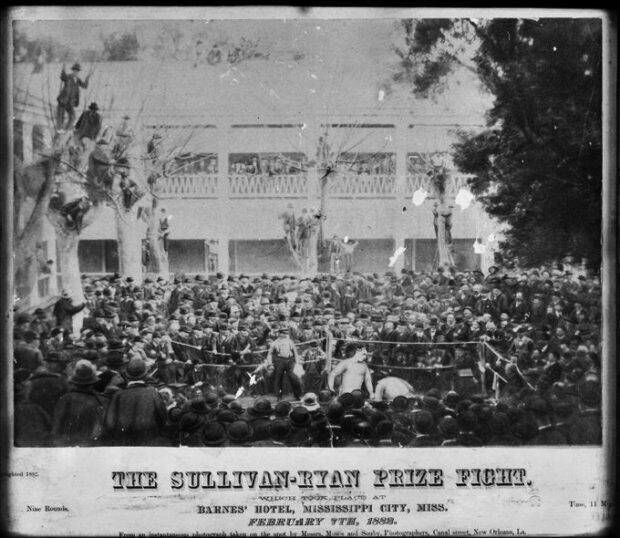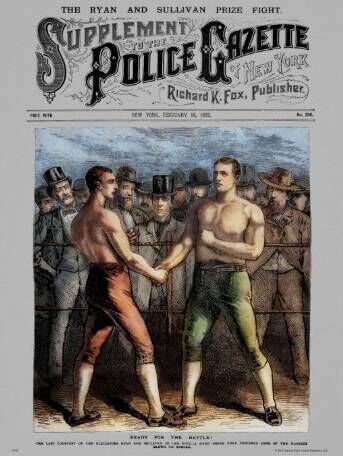John L Sullivan: The son of Kerry who became America's first sporting icon

Paddy Ryan and John L Sullivan engaged in a clandestine prize-fight with the title of Champion of America at stake.
This is a weekend to take a step back in time, back to the town of Mississippi City in Harrison County, Mississippi where on February 7 1882, Paddy Ryan and John L Sullivan engaged in a clandestine prize-fight, an activity outlawed in all states of the USA, with the title of Champion of America at stake.
A prize-fighter in the eyes of the law was a professional criminal and practitioners occupied a place on the social spectrum occupied by labourers, saloon keepers, gamblers, criminals and prostitutes.
Paddy Ryan was born in Thurles in 1853 and the family settled in upstate New York after emigrating in 1861. Labouring as a blacksmith’s helper and as a lock tender on the Erie Canal developed his trademark power and strength. Paddy later opened a saloon in the West Troy district where drinking and fighting were the twin pillars of male culture. He took care of his own security and a bar notice offered both advice and a warning. ‘All the fighting done here, I do,’ it read.
Jim Killoran, the athletic instructor at the local polytechnic institute, added some technical expertise to Ryan’s raw instincts and Paddy, ‘the Trojan Giant’, made his ring debut against Joe Goss on 30 May 1880 at Collier’s Station, West Virginia. Goss’s trash talking (‘You Irish son of a bitch’) was no match for Ryan’s punching power and the bare knuckle contest ended after 90 minutes in the 87th round when Goss retired. After one bout, Paddy Ryan was the new prize-fighting champion of America.
John L Sullivan was born in October 1858 in Boston, Massachusetts, the son of the diminutive and pugnacious Mike Sullivan from Abbeydorney, Co Kerry, and the formidable Catherine Kelly from Athlone. After his formal education, Sullivan drifted through a number of apprenticeships. Plumbing, tin smiting and masonry were rejected in turn and as John L’s strength developed boxing’s lure became greater.
Prize-fighting was strictly outlawed in Boston but an exhibition of physical skill as part of an evening’s entertainment was legitimate. On a night out in 1878, John L stepped into the ring in his street clothes, rolled up his sleeves, laced on a pair of boxing gloves for the first time and in less than two minutes dispatched Jack Scannell, a local tough.
“I didn’t know a thing about boxing then,” he later explained, “but I went at him for all I was worth and licked him quick.” John L was converted and became a regular participant in the sparring exhibitions. He was, in the words of his biographer, Michael T. Isenberg, “A raw-boned young man, almost twenty-one, remarkable for his strength and brute power, but a rough diamond if ever there was one.”
In 1880, Sullivan introduced himself to New York city’s boxing crowd. Back in Boston, Joe Goss was hammered in an exhibition as Goss prepared to meet Paddy Ryan. This ‘exhibition’ received front page coverage in the Boston Globe and the city had a new cult hero. On Christmas Eve, 1880 in an boarded-up tavern in Cincinnati, 30 people watched Sullivan dismantle John Donaldson in his prize-fighting debut.

John Flood survived just eight rounds in a prize fight that took place on a barge in the Hudson River. In July 1881, John L and his friend Billy Madden began ‘an exhibition of the science of boxing ‘ tour of the north-eastern and mid-west cities of the USA. Even better, 50 dollars were on offer to any man who survived four rounds in the ring with Sullivan under the Queensberry Rules. The tour, the first of its kind in American sport, established John L Sullivan’s national reputation. He was now the leading challenger for Paddy Ryan’s champion of America title.
Another Irishman played a central role in making the fight happen. Belfast-born Richard K Fox, a promotional genius, emigrated to New York in 1874 and within two years he controlled the ailing National Police Gazette weekly magazine. Fox’s recipe for success was to give the reading public the stories they didn’t read in the respectable press. According to Matthew T Isenberg, the Gazette became ‘the most lurid journal ever published in the United States, an endless weekly panoply of buxom showgirls, crime, sex and murder’.
Boxing stories became an important part of the mix. And when the weekly circulation of 150,000 pushed up to 400,000 prior to the Goss-Ryan fight, the Gazette was established as the leading authority on prize-fighting.
Sullivan had been calling out Ryan for several months before a deal was finally made but the champion was reluctant to step into the ring again. A new saloon in Albany occupied his time and his weight had ballooned to over 17 stone. The serious negotiations began at the offices of the Gazette in New York on 14 September 1881 and agreement on stakes, stakeholders, rules and possible venues was reached two weeks later. Ryan and Sullivan would meet ‘within 100 miles of New Orleans’ on 7 February under the London Prize Fight Rules. These bare knuckle contests allowed grappling and wrestling and a round ended when a man went to ground. A prize-fight ended when one pugilist surrendered.
A bitter personality clash between Richard Fox and Sullivan helped to secure the deal and Fox offered to back Ryan for $5,000 in the hope that John L was beaten.
Ryan and Sullivan arrived in New Orleans in December and prize-fight followers from across the USA flooded into the city, people that ‘are not only low scoundrels, but arrant cowards, equally ready to pick a pocket or stab an enemy in the dark’, according to the New York Times. City fathers intervened to force the fight out of the city. The interested parties cut a deal with the Louisville and Nashville Railroad Company to run an excursion train to Mississippi City and those involved would be back in the state of Louisiana before the Mississippi authorities knew what was planned.
Early in the morning of February 7, 1882, Paddy Ryan and John L Sullivan and their handlers, and over 2,000 passengers from every walk of life (paying $10 each) climbed aboard the special train headed for Mississippi City about 70 miles north of New Orleans. Only a few knew the location of the fight venue. The party reached the city at 10.30am, a ring was quickly prepared on the front lawn of the Barnes Hotel ‘by invitation of the landlord who reaped a rich harvest by selling standing room in the surrounding gallery at $5 a head. Among the numbers were at least a score of the women of the neighbourhood’, the New York Times reported.
Some opted to climb the nearby trees for their vantage points. Judges, bankers, and merchants surrounded the ring as well as gamblers, pugilists, restauranteurs, saloon keepers and ward politicians.
Paddy Ryan’s doubts about accepting the challenge of Sullivan was confirmed within seconds of the fighters stepping up to the mark at noon. John L attacked from the start ‘with violence amounting almost to ferocity, breaking down Ryan’s guards with his terrific blows and following up the attack by clinching and wrestling’.
The first round lasted just 30 seconds and the opening three rounds lasted less than a minute. Ryan took a terrible beating and according to the New York Times it became clear, in the sixth round, that ‘Ryan was not only suffering but was somewhat afraid of his opponent’. Ryan landed one big punch in the eighth round with little impact and it all ended a round later as a defenceless Ryan absorbed a flurry of punches to the face before he collapsed to the ground. His handlers threw in the sponge and in less than eleven minutes the prize-fight was all over.
A reporter visited Ryan’s dressing room and found him ‘lying in an exhausted condition on his bed, badly disfigured in the face, his upper lip being cut through and his nose disfigured. He did not move but lay panting. Stimulants were given him to restore him. He is terribly punished on the head’.

Sullivan jumped from the ring, returned to the hotel and put on his street clothes and raced back to the train. The spectators did likewise and by 2pm normal order was resumed in Mississippi City. The fight captured the public’s interest from ‘school boys and shoeblacks to staid men of business’. Crowds flocked in front of bulletin boards of newspaper offices across America seeking reports from the scene of the action. Telegraph offices were besieged and travel in Boston’s narrow twisting streets was obstructed. In New York, over $100,000 was gambled on the outcome of the fight.
When the sums were totted, Paddy Ryan was the loser on several levels. Under the London Prize Rules the fight was a winner take all event. John L Sullivan cleared a profit of $4,500 for what was his first bare knuckle encounter and another $600 for his share of the excursion fares. Paddy Ryan ended up with just $85 of the excursion money. When word of the result reached Troy, Mrs Ryan refused to believe that her husband had lost. She told reporters ‘that Sullivan, could never whip Paddy, I know he could not’.
Ryan’s mother-in-law was even more bullish. Mrs Gattins reportedly brandished her bare arm and commented ‘no indeed he couldn’t. I could lick that man, Sullivan meself’. Unfortunately, the stories were true. In a post-fight reflection, Ryan told reporters that he was ‘meant to have retired before, but you know how it is. When you whip somebody there is always somebody else who wants to try his hand, and I am caught this time’.
The history of the sport is littered with fighting men who made the same mistake.
At just 23 years of age well on the way to becoming an alcoholic, John L Sullivan was champion of the world and the first superstar of American sport.

Unlimited access. Half the price.
Try unlimited access from only €1.50 a week
Already a subscriber? Sign in
CONNECT WITH US TODAY
Be the first to know the latest news and updates










